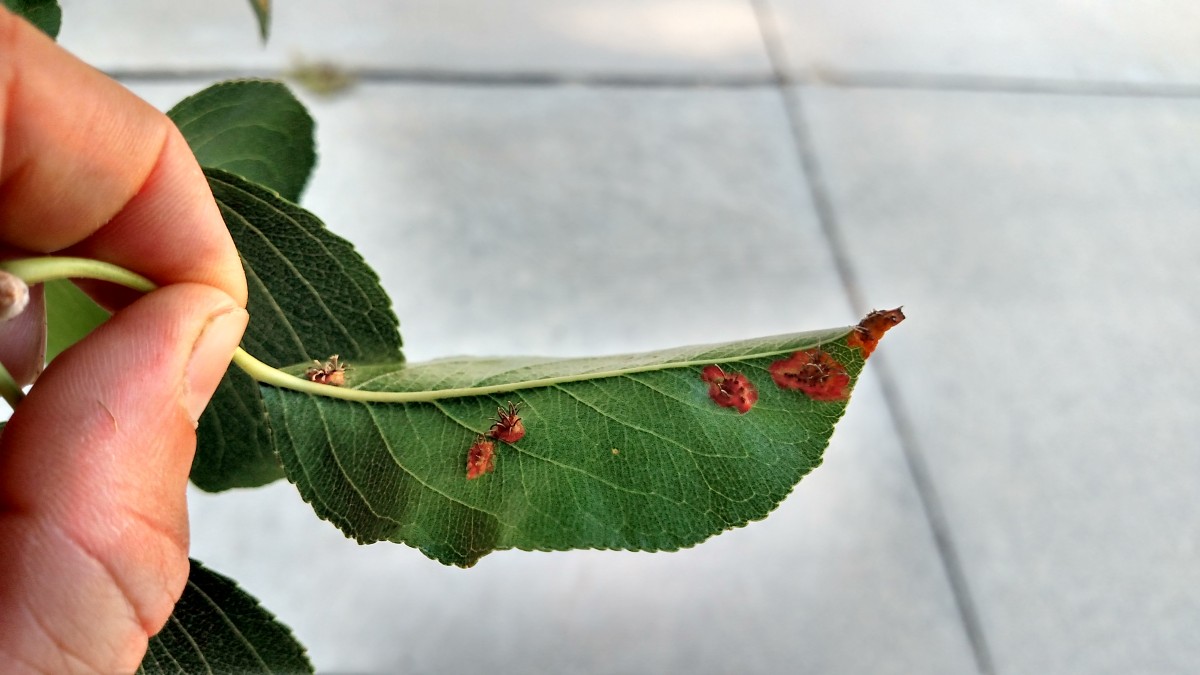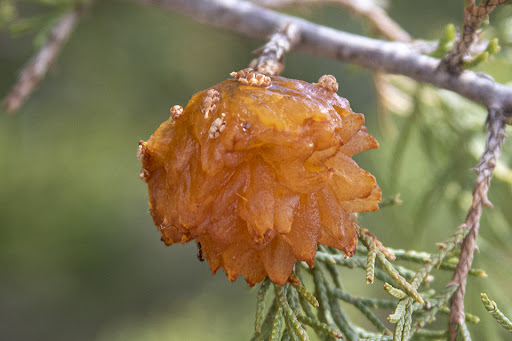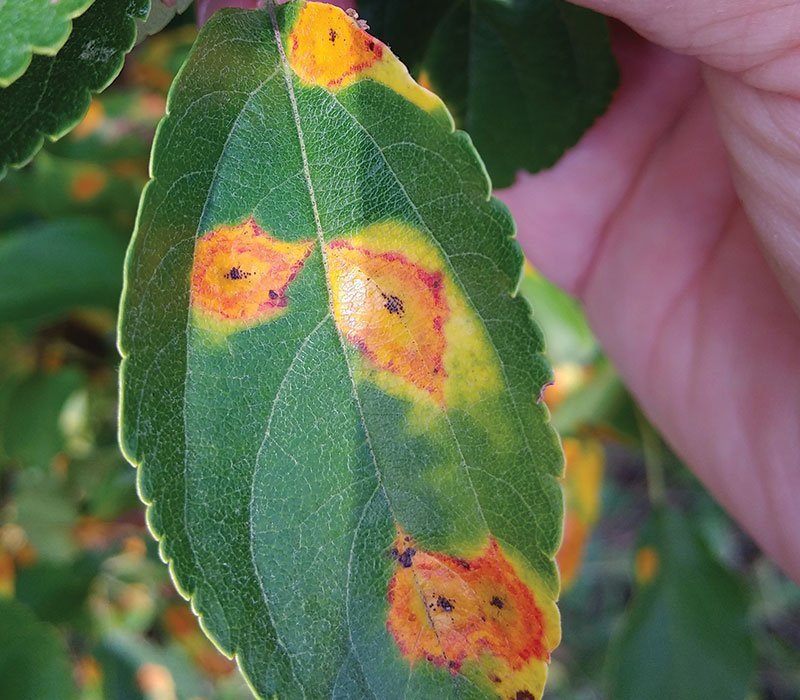What is Cedar Apple Rust?
Cedar Apple Rust is a unique fungal disease that requires two different host trees to complete its life cycle, typically eastern red cedar (or other junipers) and apple or crabapple trees. Caused by the fungus Gymnosporangium juniperi-virginianae, this disease is especially common in Missouri and the St. Louis region due to the widespread planting of both susceptible host trees.
While it rarely kills trees outright, it can significantly weaken apple and crabapple trees, causing early leaf drop, distorted fruit, and reduced vigor. On cedars, it produces odd orange gelatinous galls that emerge in spring. Cedar Apple Rust is a seasonal but persistent threat in residential and commercial landscapes, especially where both host species are planted near each other.
What Does Cedar Apple Rust Look Like: The Signs You Might Have It
Cedar Apple Rust produces distinct symptoms on both apple/crabapple trees and junipers (especially eastern red cedar). This disease becomes highly visible in spring when moisture is high, especially during wet seasons in Missouri. The bizarre orange jelly-like growths on cedars are a key giveaway that Cedar Apple Rust is active in your area.
Knowing what to look for on each host is key to early detection and effective management.
On Apple and Crabapple Trees:
- Small yellow-orange leaf spots appear in late spring or early summer
- Spots darken over time, often developing black or red dots in the center (these are spore-producing structures)
- Leaves may curl or become distorted as the disease progresses
- Infected leaves may drop prematurely, especially in mid to late summer
- Fruit lesions can also appear, making apples blemished and prone to rot
- Severe cases can lead to overall thinning and stress on the tree
On Eastern Red Cedar or Other Junipers:
- Small brown galls (pea to golf-ball-sized) form on twigs during fall and winter
- In spring, during wet conditions, galls produce bright orange, gelatinous tendrils
- These “telial horns” release spores that infect nearby apple/crabapple trees
- Galls dry up and may persist on twigs even after spores are released
How Cedar Apple Rust Spreads to Other Trees
Cedar Apple Rust has a complex, two-host life cycle, meaning it cannot survive on just one type of tree. It relies on both junipers (typically eastern red cedar) and apple or crabapple trees to complete its annual infection process.
Here’s how the disease spreads from tree to tree:
- Stage 1: Overwintering on Cedar Trees
In late summer and fall, small brown galls develop on cedar tree twigs. These galls remain dormant throughout the winter.
- Stage 2: Spring Activation and Spore Release
When spring arrives with warm, rainy weather, the galls swell and produce bright orange, gelatinous tendrils known as telial horns. These structures release spores into the air.
- Stage 3: Wind-Borne Spores Reach Apple Trees
The spores are carried by the wind, sometimes for miles, and land on newly emerged apple or crabapple leaves, fruit, and stems. This leads to the development of the rust-colored lesions that mark infection.
- Stage 4: Apple Tree Spores Return to Cedars
Later in the season, a different type of spore develops on the underside of infected apple tree leaves. These spores are carried back to nearby cedars, where they infect twigs and begin forming new galls—starting the cycle all over again.
- Conditions That Promote Spread
- Moist and humid spring weather
- Nearby planting of both host trees (cedars and apple/crabapple)
- Lack of air circulation in dense landscapes
Common Trees in Missouri at Risk from Cedar Apple Rust
Cedar apple rust requires two host types to complete its life cycle: a juniper species and a member of the apple family. In Missouri, several native and ornamental trees fall into these categories and are particularly vulnerable to infection.
Common host trees affected in Missouri include:
- Eastern red cedar (Juniperus virginiana)
A widespread native tree throughout Missouri and a key overwintering host for the fungus. Though the tree itself usually survives, it plays a critical role in disease spread.
- Apple trees (Malus domestica)
Highly susceptible to cedar apple rust, these trees often show signs of reduced fruit quality, early leaf drop, and increased vulnerability to secondary stress factors.
- Crabapple trees (Malus spp.)
Popular ornamental trees in St. Louis-area landscaping. Many varieties are very sensitive to cedar apple rust, suffering repeated defoliation and aesthetic decline.
- Hawthorn (Crataegus spp.)
Some species are moderately susceptible, especially in mixed residential and woodland areas.
- Serviceberry (Amelanchier spp.)
Occasional infections are observed, particularly in areas with poor airflow and prolonged moisture.
Cedar Apple Rust Treatment & Prevention
While cedar apple rust can be a persistent issue for many Missouri homeowners, there are effective ways to reduce its impact or even prevent it altogether. The key is to break the fungus’s life cycle and increase tree resilience through smart maintenance and timely intervention.
Recommended treatment and prevention strategies:
- Remove nearby eastern red cedars
Since the fungus needs both apple-type and cedar-type hosts to survive, removing red cedars within a 1–2 mile radius (if possible) can dramatically reduce infection rates.
- Choose resistant varieties
If planting new apple or crabapple trees, select rust-resistant cultivars. Many modern crabapple hybrids have been bred for stronger disease resistance.
- Apply preventive fungicides
Fungicide treatments can protect apple and crabapple trees when applied in early spring before symptoms appear. Multiple applications may be needed during wet seasons. This is most effective when timed correctly by a certified arborist.
- Prune for airflow and sunlight
Removing crowded branches and thinning the canopy improves air circulation and light penetration, making conditions less favorable for fungal growth.
- Sanitize your trees
Rake and dispose of fallen leaves and fruit in the fall to remove potential overwintering spores.
- Regular monitoring
Early detection is key. Have your trees inspected annually to catch signs of disease before major damage occurs.
If you suspect cedar apple rust may be affecting your trees, or you just want peace of mind, scheduling a professional tree health assessment is the best next step. A local certified arborist from Ballwin Tree Service can inspect your property, identify signs of disease early, and recommend the right plan to protect your trees. Contact us today to schedule your free tree health assesment.



